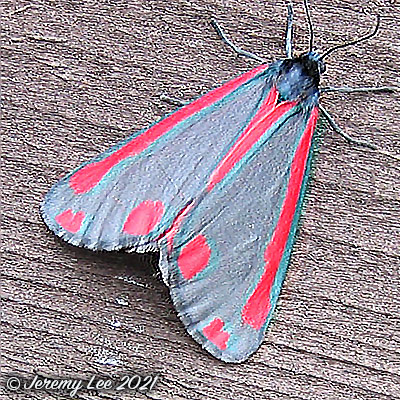
 |
|
Scientific Classifications explained » Amphibians » Ants » Aphids » Bees » Beetles » Birds » Bugs » Butterflies » Caterpillars » Damselflies » Dragonflies » Earwigs » Flies » Frog/Leafhoppers » Fungi » Galls » Grasshoppers » Harvestmen » Hoverflies » Lacewings » Ladybirds » Leaf Mines » Lichens » Mammals » Millipedes » Mosses » Moths » Sawflies » Slugs » Snails » Spiders » Trees & Shrubs » Wasps » Wild Flowers » Woodlice » Postboxes |
UK Nature > Moths > Tyria jacobaeae

Scientific Name: Tyria jacobaeae Common Name: Cinnabar Moth Tyria jacobaeae, more commonly known as the Cinnabar Moth, is a brightly coloured arctiid moth, named after the red mineral cinnabar because of the red patches on its predominantly black wings. Cinnabar moths are about 20mm long, have a wingspan of 32 to 42 mm and are day-flying insects. Like many other brightly coloured moths, it is unpalatable. The larvae use members of the genus Senecio as foodplants; many members of the genus have been recorded as foodplants, but for long-term population success, the presence of the larger species such as ragwort is needed. Smaller plant species, such as groundsel, are sometimes used, but since the species lays its eggs in large batches, survival tends to be reduced. The bright colours of both the larvae and the moths act as warning signs, so they are seldom eaten by predators. |
|

https://www.uknature.co.uk is a website dedicated to showing the immense diversity of UK nature and wildlife. Our vast range of habitats, from lowland arable to snow covered mountains, from storm-ravaged coastlines to peaceful inland freshwater lakes and rivers, from dry, sandy heaths to deciduous and coniferous forests, all these habitats contribute to the abundance of UK nature. We have wild birds in huge numbers either residing or visiting our shores (597 recorded species as at July 2013) and we must also not forget the humble back garden with its grass lawns, flower beds filled with nectar rich flowers, shrubs and trees, all designed to attract huge numbers of insects such as bees, moths, butterflies and hoverflies; and finally the small ponds which provide safe havens for frogs, toads, newts and even slow worms and grass snakes. www.uknature.co.uk is the showcase for my personal passion, photographing uknature in all its glory. I sincerely hope you all enjoy the fruits of my labours. This site and all images contained therein is © Jeremy Lee 2004 - 2025. All Rights Reserved. Site design by Jeremy Lee. Site development & IT Support by Stuart Lee. |